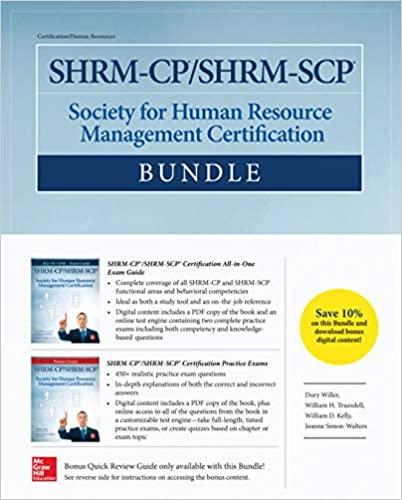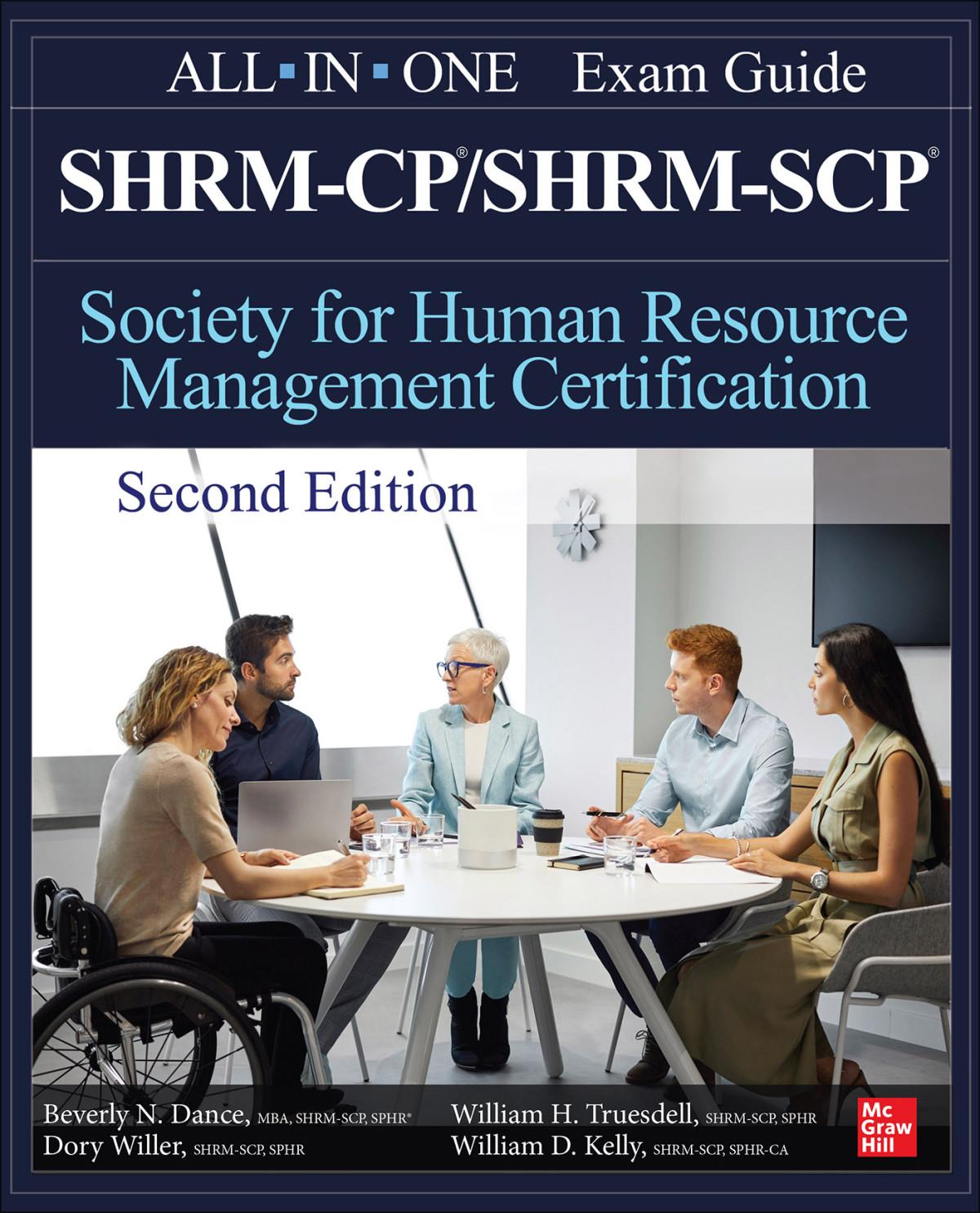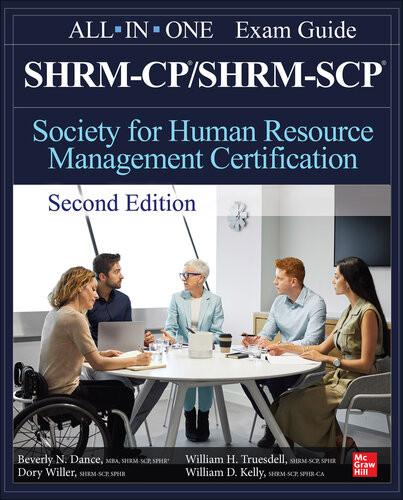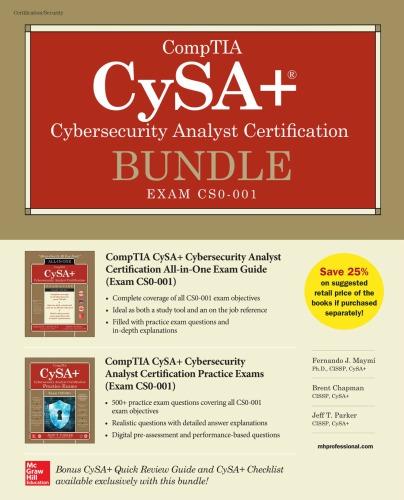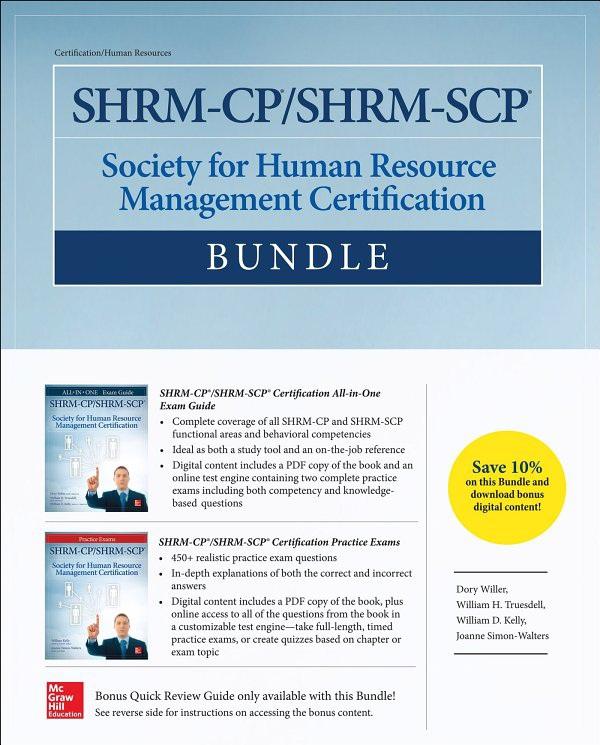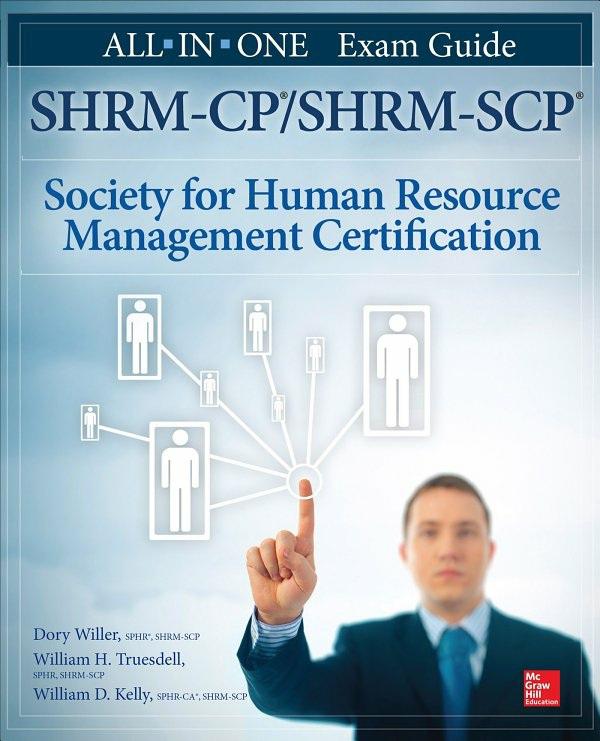https://ebookmass.com/product/shrm-cp-shrm-scp-
Instant digital products (PDF, ePub, MOBI) ready for you
Download now and discover formats that fit your needs...
SHRM-CP/SHRM-SCP Certification All-In-One Exam Guide, 2nd Edition Beverly Dance
https://ebookmass.com/product/shrm-cp-shrm-scp-certification-all-inone-exam-guide-2nd-edition-beverly-dance/
ebookmass.com
Shrm-Cp/Shrm-Scp Certification All-In-One Exam Guide, Second Edition Beverly Dance
https://ebookmass.com/product/shrm-cp-shrm-scp-certification-all-inone-exam-guide-second-edition-beverly-dance/
ebookmass.com
Comptia Cysa+ Cybersecurity Analyst Certification Bundle (Exam Cs0-001) Maymi
https://ebookmass.com/product/comptia-cysa-cybersecurity-analystcertification-bundle-exam-cs0-001-maymi/ ebookmass.com
Planning for Community Phil Heywood
https://ebookmass.com/product/planning-for-community-phil-heywood/
ebookmass.com
Copyright © 2019 by McGraw-Hill Education. All rights reserved. Except as permitted under the United States Copyright Act of 1976, no part of this publication may be reproduced or distributed in any form or by any means, or stored in a database or retrieval system, without the prior written permission of the publisher, with the exception that the program listings may be entered, stored, and executed in a computer system, but they may not be reproduced for publication.
ISBN: 978-1-25-958343-8
MHID: 1-25-958343-0
The material in this eBook also appears in the print version of this title:
ISBN: 978-1-25-958342-1, MHID: 1-25-958342-2.
eBook conversion by codeMantra
Version 1.0
All trademarks are trademarks of their respective owners. Rather than put a trademark symbol after every occurrence of a trademarked name, we use names in an editorial fashion only, and to the benefit of the trademark owner, with no intention of infringement of the trademark. Where such designations appear in this book, they have been printed with initial caps.
McGraw-Hill Education eBooks are available at special quantity discounts to use as premiums and sales promotions or for use in corporate training programs. To contact a representative, please visit the Contact Us page at www.mhprofessional.com.
All trademarks or copyrights mentioned herein are the possession of their respective owners and McGraw-Hill Education makes no claim of ownership by the mention of products that contain these marks.
Information has been obtained by McGraw-Hill Education from sources believed to be reliable. However, because of the possibility of human or mechanical error by our sources, McGraw-Hill Education, or others, McGraw-Hill Education does not guarantee the accuracy, adequacy, or completeness of any information and is not responsible for any errors or
omissions or the results obtained from the use of such information.
TERMS OF USE
This is a copyrighted work and McGraw-Hill Education and its licensors reserve all rights in and to the work. Use of this work is subject to these terms. Except as permitted under the Copyright Act of 1976 and the right to store and retrieve one copy of the work, you may not decompile, disassemble, reverse engineer, reproduce, modify, create derivative works based upon, transmit, distribute, disseminate, sell, publish or sublicense the work or any part of it without McGraw-Hill Education’s prior consent. You may use the work for your own noncommercial and personal use; any other use of the work is strictly prohibited. Your right to use the work may be terminated if you fail to comply with these terms.
THE
WORK IS PROVIDED “AS IS.” McGRAW-HILL EDUCATION AND ITS LICENSORS MAKE NO GUARANTEES OR WARRANTIES AS TO THE ACCURACY, ADEQUACY OR COMPLETENESS OF OR RESULTS TO BE OBTAINED FROM USING THE WORK, INCLUDING ANY INFORMATION THAT CAN BE ACCESSED THROUGH THE WORK VIA HYPERLINK OR OTHERWISE, AND EXPRESSLY DISCLAIM ANY WARRANTY, EXPRESS OR IMPLIED, INCLUDING BUT NOT LIMITED TO IMPLIED WARRANTIES OF MERCHANTABILITY OR FITNESS FOR A PARTICULAR PURPOSE. McGraw-Hill Education and its licensors do not warrant or guarantee that the functions contained in the work will meet your requirements or that its operation will be uninterrupted or error free. Neither McGraw-Hill Education nor its licensors shall be liable to you or anyone else for any inaccuracy, error or omission, regardless of cause, in the work or for any damages resulting therefrom. McGraw-Hill Education has no responsibility for the content of any information accessed through the work. Under no circumstances shall McGraw-Hill Education and/or its licensors be liable for any indirect, incidental, special, punitive, consequential or similar damages that result from the use of or inability to use the work, even if any of them has been advised of the possibility of such damages. This limitation of liability shall apply to any claim or cause whatsoever whether such claim or cause arises in contract, tort or otherwise.
consulting services and support for small business enterprises. Bill’s experience includes more than 40 years of professional-level HR responsibilities that include 22 years within industry at Bechtel and later at Brown and Caldwell as an environmental engineer. His credentials include experience in employee relations, state and federal legal compliance, staffing and recruitment, equal employment opportunity and affirmative action, compensation, benefits, training and development, health and safety, and government contract management. Bill also has 20 years’ HR consulting experience that includes providing HR services, support, and advice to a wide range of Northern California clients. He also has 17 years’ experience as an instructor for the University of California – Berkeley extension program teaching Management of Human Resources; Recruiting, Selection, and Placement; California Employment Law; and professional HR certification preparation courses. Bill has more than 18 years’ experience teaching the Professional PHR/SPHR Certification Preparation Course as well as 7 years’ experience teaching the California HR Certification Preparation Course for the Society for Human Resource Management (SHRM) and the Northern California HR Association (NCHRA). He played a key role in the development of California’s HR certification credential; also, he was the project manager for the team of California HR professionals who developed SHRM’s first California Learning System in support of the California certification. Bill’s professional leadership also included roles on the board of directors and national vice president for the Society for Human Resource Management; the board of directors and president for the HR Certification Institute (HRCI); state director, California State Council of SHRM; the board of directors and president for the Northern California HR Association (NCHRA); and commissioner and chair, Marin County Personnel Commission. Bill received his B.S. in political science from Spring Hill College in Mobile, Alabama, and undertook post-graduate studies in organizational management at the College of William and Mary in Williamsburg, Virginia, and the University of Virginia in Richmond, Virginia. Prior to HR, Bill had a military career achieving the rank of Major in the United States Army with tours of duty in the United States, Germany, Thailand, and Vietnam.
About the Contributing Author
Beverley N. Dance, MBA, SHRM-SCP, SPHR-CA, CCP, is a human resource professional with significant HR management and independent consulting experience. She is the founder and principal of Dance Associates, providing human resource consulting; supporting a variety of clients including commercial businesses, nonprofits, and higher-educational institutions; and coaching leadership and individuals.
Beverly joined the Society for Human Resources Management faculty in 2007 and facilitates SHRM’s certification preparation and compensation classes. Beverly also facilitates for the Northern California Human Resources Association where she is a certified facilitator and certified mentor. She is approaching facilitating certification class number 100 and has presented at the HR West conference three times and at an SHRM Annual conference.
Beverly earned a master’s degree in business administration from the Haas School of Business at the University of California – Berkeley with a concentration in organizational design and industrial relations. Beverly has earned the Certified Compensation Professional (CCP) and Certified Employee Benefit Specialist (CEBS) certifications.
References
Chapter 3 U.S. Laws and Regulations
What You Need to Know Concerning Employee Management
1. When You Have One or More Employees
1.1. The Clayton Act (1914)
1.2. The Consumer Credit Protection Act (1968)
1.3. The Copeland “Anti-Kickback” Act (1934)
1.4. The Copyright Act (1976)
1.5. The Davis-Bacon Act (1931)
1.6. The Dodd-Frank Wall Street Reform and Consumer Protection Act (2010)
1.7. The Economic Growth and Tax Relief Reconciliation Act (EGTRRA) (2001)
1.8. The Electronic Communications Privacy Act (ECPA) (1986)
1.9. The Employee Polygraph Protection Act (1988)
1.10. The Employee Retirement Income Security Act (ERISA) (1974)
1.11. The Equal Pay Act (EPA) (Amendment to the FLSA) (1963)
1.12. The FAA Modernization and Reform Act (2012)
1.13. The Fair and Accurate Credit Transactions Act (FACT) (2003)
1.14. The Fair Credit Reporting Act (FCRA) (1970)
1.15. The Fair Labor Standards Act (FLSA) (1938)
1.16. The Foreign Corrupt Practices Act (FCPA) (1997)
1.17. The Health Information Technology for Economic and Clinical Health Act (HITECH) (2009)
1.18. The Health Insurance Portability and Accountability Act (HIPAA) (1996)
1.19. The Immigration and Nationality Act (INA) (1952)
1.20. The Immigration Reform and Control Act (IRCA) (1986)
1.21. The IRS Intermediate Sanctions (2002)
1.22. The Labor-Management Relations Act (LMRA) (1947)
1.23. The Labor-Management Reporting and Disclosure Act (1959)
1.24. The Mine Safety and Health Act (1977)
1.25. The National Industrial Recovery Act (1933)
1.26. The National Labor Relations Act (NLRA) (1935)
1.27. The Needlestick Safety and Prevention Act (2000)
1.28. The Norris-LaGuardia Act (1932)
1.29. The Occupational Safety and Health Act (OSHA) (1970)
1.30. The Omnibus Budget Reconciliation Act (OBRA) (1993)
1.31. The Pension Protection Act (PPA) (2006)
1.32. The Personal Responsibility and Work Opportunity Reconciliation Act (1996)
1.33. The Portal-to-Portal Act (1947)
1.34. The Railway Labor Act (1926)
1.35. The Rehabilitation Act (1973)
1.36. The Retirement Equity Act (REA) (1984)
1.37. The Revenue Act (1978)
1.38. The Sarbanes-Oxley Act (SOX) (2002)
1.39. The Securities and Exchange Act (1934)
1.40. The Service Contract Act (SCA) (1965)
1.41. The Sherman Anti-Trust Act (1890)
1.42. The Small Business Job Protection Act (1996) (SBJPA)
1.43. The Social Security Act (1935)
1.44. The Tax Reform Act (1986)
1.45. The Taxpayer Relief Act (1997)
1.46. The Trademark Act (1946)
1.47. The Unemployment Compensation Amendments Act (UCA) (1992)
1.48. The Uniformed Services Employment and Reemployment Rights Act (USERRA) (1994)
Key Concepts
The Role of Strategy
Strategy Formulation
Developing Strategy
Implementing Strategy Production
Evaluating Strategic Performance
Providing Leadership and Strategy
Functional Area 2 Talent Acquisition
Key Concepts
Organizational Staffing Requirements
Strategic Staffing
Planning for Talent Acquisition on a Global Basis
Employment Branding
Job Analysis and Job Documentation
Sourcing and Recruiting
Selection
Orientation and Onboarding
Functional Area 3 Employee Engagement & Retention
Key Concepts
Understanding Employee Engagement
Drivers and Role of Organizational Culture in Engagement
Challenges to Employee Engagement
HR’s Employee Engagement Strategy
Assessing Employee Engagement
Engaging Employees from Hiring to Separation
Performance Management
Retention
Functional Area 4—Learning & Development
Key Concepts
Learning and Development in Today’s Organizations
Adult Learning
Training and Development
Career Development
Developing Leaders
Functional Area 5 Total Rewards
Key Concepts
Total Rewards and Organizational Strategy
Compensation Structure
Compensation Systems
Benefits and Perquisites
Legislation Affecting Compensation and Benefits
Chapter Review
Questions
Answers
References
Chapter 5 Organization
Functional Area 6 Structure of the HR Function
Key Concepts
The Strategic Role of HR
Understanding the Organization
The HR Organization and Function
Measuring and Demonstrating HR Value
HR’s Role in Organizational Strategy
Functional Area 7 Organizational Effectiveness & Development
Key Concepts
Overview of Organizational Effectiveness and Development (OED)
Organizational Gap Development
Implementing OED Initiatives
Measuring Organizational Effectiveness and Development
Functional Area 8 Workforce Management
Key Concepts
Organizational Workforce Requirements
Workforce Planning
The Staffing Plan
Summary
Interpersonal Cluster
Behavioral Competency 3 Relationship Management
Key Concepts Definition
Basic Proficiency Indicators
Proficiency Indicators for Senior HR Professionals
Summary
Behavioral Competency 4 Communication
Key Concepts
Definition
Proficiency Indicators for All HR Professionals
Proficiency Indicators for Senior HR Professionals
Summary
Behavioral Competency 5 Global and Cultural Effectiveness
Key Concepts Definition
Proficiency Indicators for All HR Professionals
Proficiency Indicators for Senior HR Professionals
Summary
Business Cluster
Behavioral Competency 6 Business Acumen
Key Concepts
Definition
Proficiency Indicators for All HR Professionals
Proficiency Indicators for Senior HR Professionals
Summary
Behavioral Competency 7 Consultation
Key Concepts
Definition
Proficiency Indicators for All HR Professionals
Proficiency Indicators for Senior HR Professionals
Summary
Behavioral Competency 8 Critical Evaluation
Key Concepts Definition
Proficiency Indicators for All HR Professionals
Proficiency Indicators for Senior HR Professionals
Summary
Chapter Review Questions
Answers
References
Part III Appendixes
Appendix A List of Common HR Acronyms
Appendix B Case Laws by Chapter
Chapter 4: People
Chapter 5: Organization
Chapter 6: Workplace
Chapter 7: Behavioral Competencies
Appendix C For Additional Study
Appendix D About the Digital Content
System Requirements
Your Total Seminars Training Hub Account
Privacy Notice
Single User License Terms and Conditions
TotalTester Online
TotalTester Online Practice Exam Software
Technical Support
Glossary
Index
INTRODUCTION
Allow us to be the first to congratulate you on deciding to sit for the SHRM certification and obtain your SHRM Certified Professional (SHRM-CP) or SHRM Senior Certified Professional (SHRM-SCP) certification! Professional certifications are a mark of distinction that sets you apart in the profession and speaks volumes as to your commitment to your craft. In 2017, the Society for Human Resource Management (SHRM) awarded its 100,000th certification, just 2 years after first launching its “next-generation” HR professional certifications. It is our belief that HR professional certifications are important to you in your job as an HR professional because they endorse your knowledge and expertise to employers and clients.
Through this book, we can help you ready yourself for the type of materials you will be expected to have mastered. You bring your own professional experience to the process. Combining the two, you can be better able to answer situational-based and knowledge-based questions about human resource situations that you may find on the exam.
We want you to be successful. Having a professional certification is more critical every day in the world of work. It may be a requirement of your next job assignment or the promotional opportunity you are pining for in your organization. You may find that you want to place certification on the list of required qualifications for the future HR professionals you hire. In either event, we wish you the best professional regards and success in passing your exam and earning the prestigious designation of SHRM-CP or SHRM-SCP.
SHRM Certifications
This book was first written in 2015, which was the first year of the new SHRM exams. Over the next couple of years, SHRM modified some of the material to finally land on its official credentialing. We believe that the dust has settled and that the exam’s organization, weightings, and content are now
set in stone and you, the reader/exam taker, will find this book of immense help in helping you study and pass your exam.
How to Use This Book
We believe this book covers the entire SHRM Body of Competency and Knowledge (BoCK) identified in the three specific domains that topics are organized into and in the eight behavioral competencies identified by SHRM for application by those in the human resource profession. The manner in which we present the information is based on a learning principle we call foundational knowledge. This means we’ve purposefully organized this book to ensure that the reader first grasps the foundational knowledge items required of the profession. That is why we have placed U.S. laws as one of the first chapter topics; followed by the BoCK knowledge domain chapters of People, Organization, and Workplace; and then the behavioral competency information.
Additionally, within the writing, we have presented the essential “guts” of the information that we feel is minimally necessary for the exam purposes and pointed you to additional resources to discover more information on topics such as theories. It is our belief that as readers progress through the material and progressively move through with a sure-footed understanding of the “what,” they will then be able to progress to the “how” of applying the topics to their roles in HR. We know that the information presented in this book for passing the exam is concise studying for the exam is no cake walk. The presentation of material was specifically designed to help the selfdirected learner by covering information they may already be well familiar with, and yet offering new information in a succinct manner for ease of learning.
Chapter 1
In Chapter 1 we explain everything you need to know about the different types of HR certifications and the benefits of professional certification (such as boosting your credibility as an HR professional and providing a platform to show you’re ready to take on the next-level challenge for your career).

